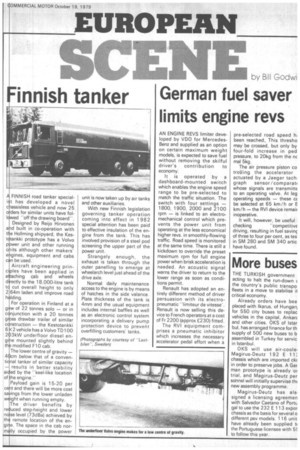German fuel saver limits engine revs
Page 45

If you've noticed an error in this article please click here to report it so we can fix it.
AN ENGINE REVS limiter developed by VDO for MercedesBenz and supplied as an option on certain maximum weight models, is expected to save fuel without removing the skilful driver's contribution to economy.
It is operated by a dashboard-mounted switch which enables the engine speed range to be pre-selected to match the traffic situation. The switch with four settings — 1800, 1900, 2000 and 2100 rpm — is linked to an electromechanical control which prevents the power unit from operating at the less economical higher revs, in smoothly-flowing traffic. Road speed is monitored at the same time. There is still a kickdown to override the preset maximum rpm for full engine power when brisk acceleration is needed. An acoustic signal warns the driver to return to the lower range as soon as conditions permit.
Renault has adopted an entirely different method of driver persuasion with its electropneumatic ''limiteur de vitesse'. Renault is now selling this device to French operators at a cost of Fr 2200 (approx £230) fitted.
The RVI equipment comprises a pneumatic inhibitor which increases the necessary accelerator pedal effort when a pre-selected road speed hi; been reached., This thresho may be crossed, but only by four-fold increase in ped pressure, to 20kg from the nc mal 5kg.
The air pressure piston co trolling the accelerator actuated by a Jaeger tech, graph sensor /comparatt whose signals are transmittE to an operating valve. At leg operating speeds — these CE be selected at 65 km/h or E km/h — the RVI device remair inoperative.
It will, however, be useful
checking -competitive driving, resulting in fuel savinc of three to four per cent, as tes in SM 280 and SM 340 artic have found.












































































































































